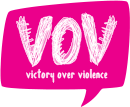![]()
![]() The VOV movement was launched in 1999 in response to the growing concern over youthrelated violence, including the Columbine High School shootings in Littleton, Colorado. The VOV campaign envisions a global movement of ordinary people becoming the driving force for building a culture of peace through dialogue and action in their daily lives. We aim to inspire people, especially young people, to identify and counteract the root causes of violence in their lives, homes, schools, and local communities through awareness, introspection, individual empowerment and a creative commitment to dialogue and action.
The VOV movement was launched in 1999 in response to the growing concern over youthrelated violence, including the Columbine High School shootings in Littleton, Colorado. The VOV campaign envisions a global movement of ordinary people becoming the driving force for building a culture of peace through dialogue and action in their daily lives. We aim to inspire people, especially young people, to identify and counteract the root causes of violence in their lives, homes, schools, and local communities through awareness, introspection, individual empowerment and a creative commitment to dialogue and action.
CORE CONCEPTS
The philosophy underlying the VOV approach to violence prevention can be broken down into five core concepts. As you continue to learn about these concepts and reflect on how they connect to your daily life, you can translate theory into action, empowering yourself to make nonviolence a daily practice.
Click to learn more about each of our Core Concepts.
The relationship between passive violence and physical violence
Passive violence is anything we say, think, or do that undermines the fundamental dignity of our own lives or the lives of others. Passive violence is (1) verbal/emotional abuse (ex: teasing, taunting, bullying, ostracizing), (2) oppression (ex: economic, political, cultural, religious, etc.), (3) apathy/indifference (choosing to step back and do nothing when you see acts of violence in your environment) or (4) negative mental judgments (dismissing someone or “profiling” them in our mind based on race, skin color, dress or other superficial quality – before getting to know them individually). Gandhi taught that passive violence is the fuel that feeds the fire of physical violence. Therefore, if we want to put out the fire of physical violence, logically we have to cut off the fuel supply. When we become conscious of the little things we do every day that are passively violent, we can make better decisions and help build the culture of peace.
The value of dialogue
Through the power of virtue-based dialogue, VOV encourages authentic respect, trust and friendship among people, families, schools and local communities across all boundaries that may divide such as race, nationality, religion, age, gender, language, ethnicity, disability, sexual orientation, etc. and recognition of the common humanity we all share.
Taking responsibility
Peace is not the absence of war or violence. Peace is an active process in which each person makes a commitment to take action each day for the uplift of human dignity.
The root cause of violence
VOV defines the root cause of violence as a lack of self-identity and hope for the future. People who lack confidence in who they are can develop an insecurity complex. They may compare themselves to others and criticize or judge them because they are different. A sense of worthlessness can lead to violence.
The multi-level ecological model for understanding violence
This public health model maps out factors that predict the likelihood of violence occuring on four playing fields of our lives: individual-, relationship-, community-, and societal-levels. By taking action to increase the number of protective factors and minimize the number of risk factors in your daily life, you can be proactive in decreasing the liklihood of violence occuring and help build the culture of peace. Virtues such as courage, compassion, and seeing the interconnectedness of our lives are examples of internal protective factors that VOV strives to help each person cultivate, starting at the individual-level.
THE ECOLOGICAL FRAMEWORK MODEL
Our focus at VOV is to empower the individual. It’s a narrative about putting virtues into action (courage, creativity, sustainability, etc.) at the individual level and how such efforts can become the foundation for creating ripple effects that nurture a culture of peace and nonviolence in our relationships, communities, and societies.
We want people to learn about these virtue areas on VOV, put them into action, and share their stories for others to learn from and get inspired.

